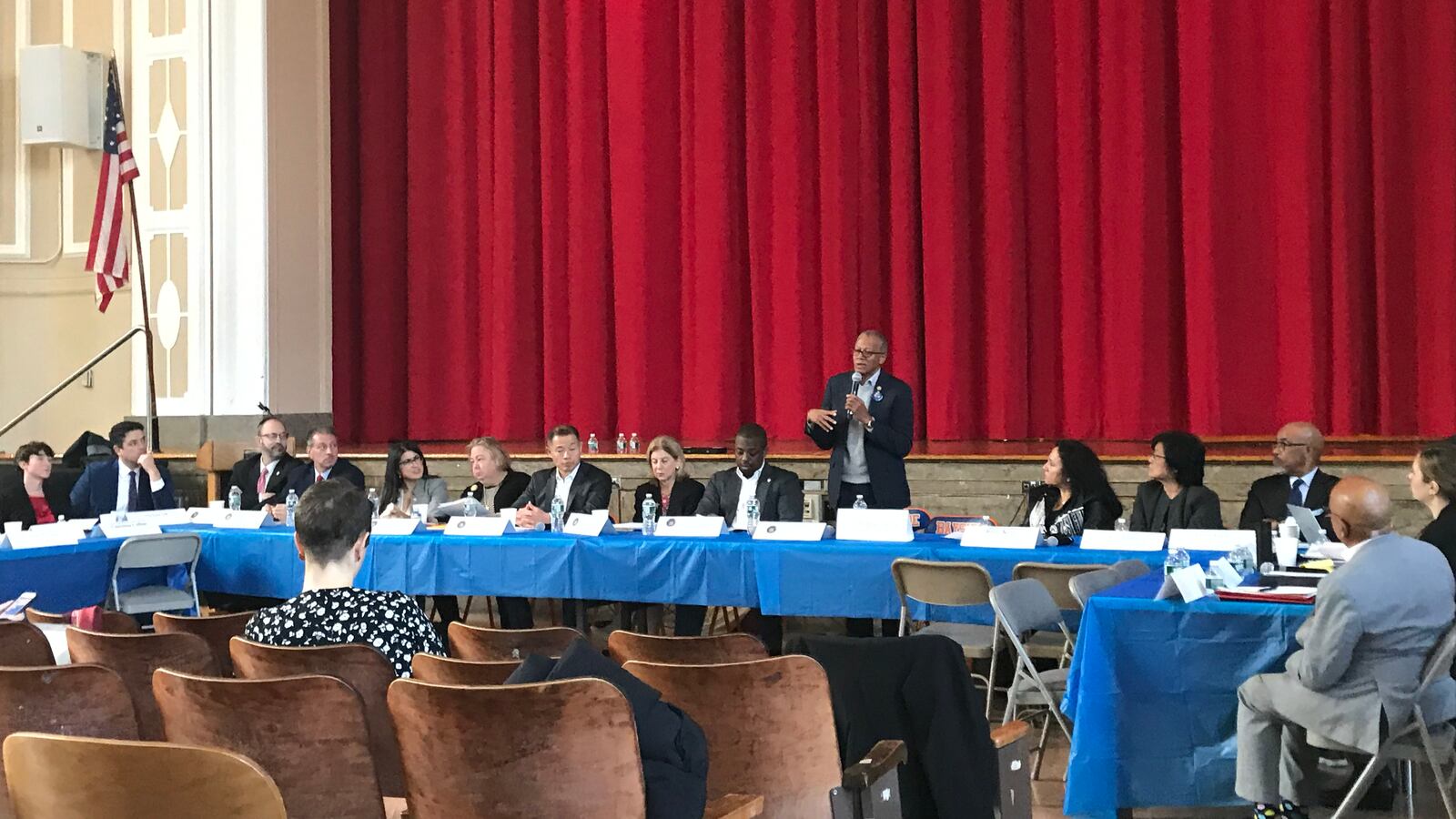How to update a major pillar of the state’s education funding formula was the goal of a roundtable held Tuesday inside a Queens high school auditorium. But parents, advocates, union officials, and even the city education department’s chief financial officer had a different message: Fully fund the existing formula before changing it.
“If you have a car and you don’t put gas in it, how do you expect it to run? How do you expect it to work?” explained Johanna Garcia, chief of staff for Sen. Robert Jackson, a Manhattan Democrat, at the public, state-led meeting. “In this case, gas is money. The Foundation Aid formula has been neglected.” (As a public school parent, Jackson, spearheaded the Campaign for Fiscal Equity, which created the funding mechanism known as Foundation Aid.)
Foundation Aid is the formula the state uses to allocate extra dollars to high-needs districts, such as New York City. While state lawmakers are now exploring how to update key elements of the aid — including how student poverty is measured — the formula has almost never been funded to the level intended, advocates and education policymakers have long contended.
That’s because the state halted funding under the formula during the recession, and after restarting it, never phased in money to the level that was originally expected. New York City is still owed $1.1 billion under the formula created in 2007, said Lindsay Oates, chief financial officer for the city’s education department.
Gov. Andrew Cuomo would likely dismiss that number. He has called the 1993 lawsuit that created the aid and subsequent efforts to boost it “ghosts of the past,” since the case has been settled. The state increased education funding last year by $1 billion for districts statewide, $618 million of that for Foundation Aid. That was the same increase as the year before and far short of what advocates, lawmakers, and the Board of Regents wanted.
During a nearly four-hour discussion, parent leaders and advocates for high-needs students shared stories about how funding constraints held schools back from offering certain programs and services. Bronx parent Tom Sheppard, a member of District 11’s community education council, said he spent his own money for a year to create an after-school photography club “for 10 kids, just to hopefully make a dent.”
Sen. Shelley Mayer, a Yonkers Democrat who chairs the state Senate’s education committee, said she launched roundtables, such as the one held Tuesday at Bayside High School in Queens, amid growing calls to rejigger certain elements of the Foundation Aid formula. For example, it uses 2000 Census data to help measure student poverty, even though there has been a Census count since then.
Tuesday’s gathering was the last of five roundtable discussions on Foundation Aid across the state.
Some advocates on Tuesday acknowledged the need to refresh or update the formula but argued that without fully funding it first, it’s not possible to see what needs to change.
Sheppard said some of his community’s schools are overcrowded, grappling with “crumbling infrastructure,” and that local principals are often forced to choose between hiring an additional teacher or funding an after-school program. “As a parent of three of the 37,000 students in District 11 in the Bronx, I’m disappointed that I have to watch the state continue to under-serve our community year after year, and decade after decade,” he said.
And Maria Bautista, campaigns director for the Alliance for Quality Education, a group that has advocated for boosting Foundation Aid, said that if there are changes to the city’s own funding formula, it’s possible things will become even more expensive. A city task force is currently reviewing how it sends money to high-need schools.
State lawmakers in attendance also acknowledged that fully feeding the formula is a key priority, which Senate Democrats had promised they would champion when they took control of the state Senate this year. Sen. John Liu, a Queens Democrat who chairs the senate’s New York City education committee, recalled Bautista approaching him at 1 a.m. in the state capitol after learning that this year’s budget would not fulfill what advocates had demanded for education funding, and telling him, “You’re no better than the Republicans.”
“And it’s true,” Liu said. “We need to do more and fund the damn thing. We’re resolved in doing that, but we can’t do it ourselves,” noting the governor’s power over budget negotiations. The key to solving school funding issues, Cuomo has said, lies in how school districts prioritize their money.
Mayer said it’s possible to “do two things at once” — talking about fixing underfunding and also finding ways to update the formula. She and Liu peppered Oates with questions about the city’s own funding formula and how poverty is measured in New York City. Once state dollars are sent to the city’s education department, it distributes the money through a process of its own, called Fair Student Funding formula. The city formula is intended to send more dollars to schools with the neediest students, such as those with disabilities and children who are learning English for the first time.
All city schools are funded at least at a 90-percent level of what they should be under Fair Student Funding, which is missing $750 million from Foundation Aid, Oates said. And under the formula, some schools receive more than 100% of what the city’s formula entitles them to.
One question Liu raised was about how the city prioritizes funding — why more high schools aren’t designated as “portfolio” schools, which receive extra funding under the city’s formula for offering specific education models, such as those with a focus on career and technical education. That’s a decision left up to Linda Chen, the city’s chief academic officer, but more portfolio schools would create extra costs for the city as it waits on more state dollars, Oates said.
Mayer and other lawmakers will host a formal public hearing on Foundation Aid Dec. 3 in New York City.

